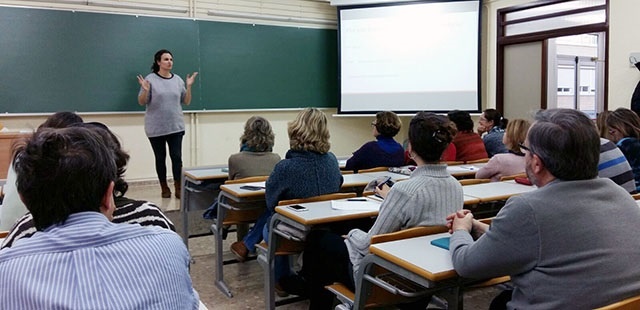The Institute of Corpuscular Physics organises a new edition of the scientific and educational training course in particle physics, addressed to the teaching staff of secondary education of the Valencian Community. Some thirty teachers of Valencian secondary schools participate in this edition. The experiments of the Large Hadron Collider (LHC) of the CERN, nuclear physics and its applications in medicine or energy or the experiments to reveal the origins of the neutrino, are, among others, the issues to be treated. The course includes a workshop to approach this knowledge to the classroom through simple experiments.
The Institute of Corpuscular Physics (IFIC, CSIC-UV) organises a new edition of its scientific and educational training course in particle physics, addressed to the teaching staff of secondary education of the Valencian Community. The course approaches the foundations of cutting-edge physics where the IFIC participates to some thirty teachers of the Valencian secondary schools chosen among more than 60 applications. The experiments of the Large Hadron Collider (LHC) of the CERN, nuclear physics and its applications in medicine or energy or the experiments to reveal the origins of the neutrino are the main issues to be treated, as well as theoretical foundations such as the theory of relativity or quantum mechanics. The course includes a workshop to approach this knowledge to the classroom through simple experiments.
This activity is carried out in collaboration with the Department of Experimental and Social Sciences Teaching of the UV and the Training, Innovation and Educational Resources Centre of the Valencian Community (CEFIRE) of Torrent, dependent on the Valencian Department of Educació, Research, Culture and Sports of the Valencian Government. It will be developed during the months of January and February in the facilities of the Faculty of Physics, ending the activity with a guided tour in the facilities of the IFIC in the Science Park of this academic institution on 13 February.
The course started yesterday with the sessions devoted to teaching techniques of particle physics in secondary school, introducing the theory which describes elementary particles and their interactions, the Standard Model. Subsequent sessions are dedicated to the foundations of current physics, beginning with the biggest parts and arriving at the smallest ones: the theory of relativity and some of its most known consequences (the existence of black holes and gravitational waves) and quantum mechanics, with phenomena such as the ‘entanglement’.
Regarding experimental physics, the course will focus on the fields where the IFIC, Severo Ochoa Excellence Centre with more than sixty years of trajectory in the study of elementary particles and their interactions, has a noteworthy presence. One of the units in which the course is structured focus on particle accelerators, which are the laboratories that reproduce the conditions where the elements that form the Universe were created. In addition to the LHC, the IFIC participates in other international particle accelerators, it works in the updating of the accelerator of the CERN from 2025 and it is involved in the design of the next generation one.
In nuclear physics, the course focuses in the structure of the atomic nucleus and its limits, with diverse experiments to study the formation of nucleus in the Universe. Among its applications it can be highlighted the production of energy through fission and medical physics, a growing discipline between nuclear physics and particle physics. The experience of the IFIC in both fields has enabled the creation of a new research infrastructure in medical physics, the IFIMED, whose people in charge teach this part of the course.
Another of the areas where the IFIC plays an important role is neutrino physics, the most distant elementary particle. The IFIC leads the experiment called NEXT, an international collaboration which wants to know if a neutrino is its own antiparticle, which would offer some vital information on the formation of our Universe. Furthermore, it participates in other big experiments: the telescopes ANTARES and KM3Net, which use the Mediterranean to capture the ghost particles, T2K (Japan) and DUNE, the major detector of neutrinos produced in a laboratory which is built in the United States.
As in the last year’s edition, the course includes a session devoted to different experiments and experiences to introduce particle physics in the classroom: from the production of a home-made fog chamber where live natural radiation can be observed to the construction of thumbnail linear and circular accelerators. The participation of students in the International Masterclass on particle physics is also addressed. It is an initiative where students of all around the world become particle physicians during one day, an initiative in which the IFIC participates since it was created.
More information:
http://cefire.edu.gva.es/sfp/index.php?seccion=edicion&id=6491748


